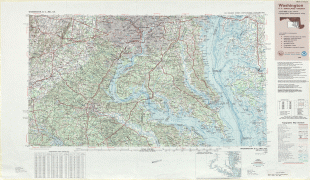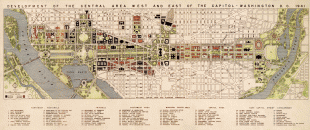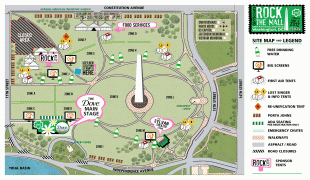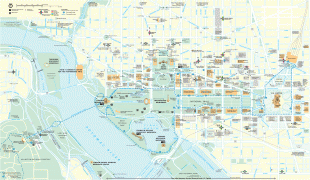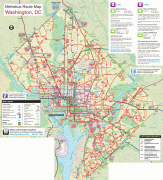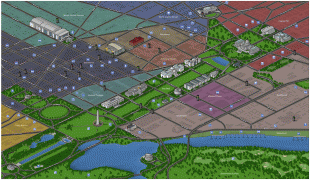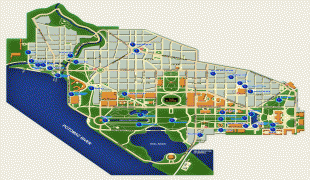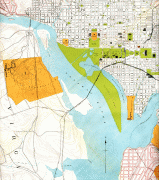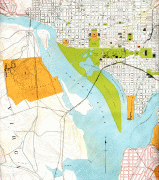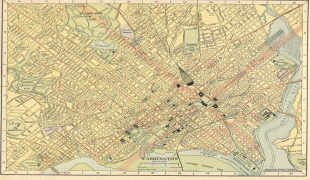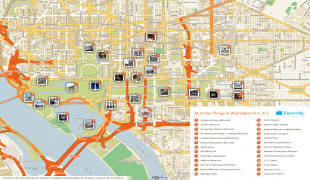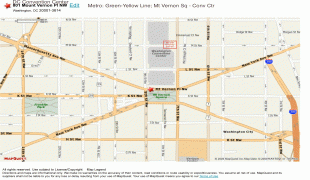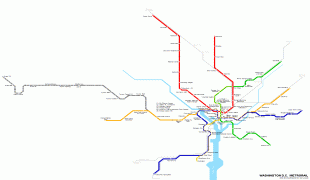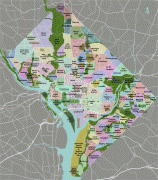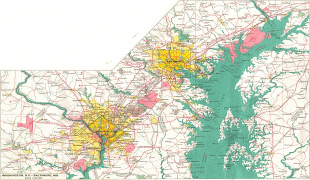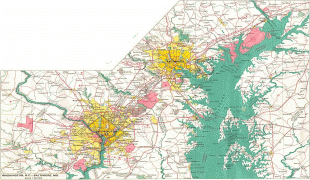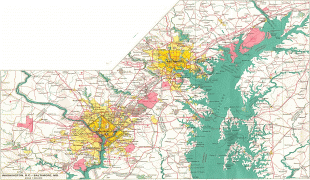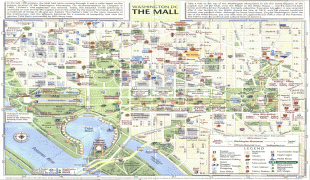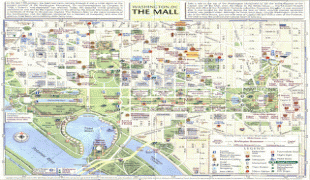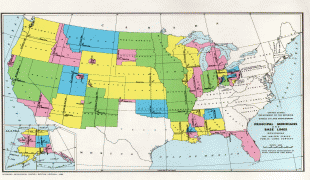Washington (District of Columbia)
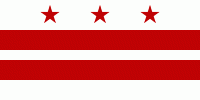 |
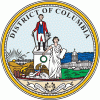 |
The U.S. Constitution provides for a federal district under the exclusive jurisdiction of Congress; the district is not a part of any U.S. state (nor is it one itself). The signing of the Residence Act on July 16, 1790, approved the creation of the capital district located along the Potomac River near the country's East Coast. The City of Washington was founded in 1791, and Congress held its first session there in 1800. In 1801, the territory, formerly part of Maryland and Virginia (including the settlements of Georgetown and Alexandria), officially became recognized as the federal district. In 1846, Congress returned the land originally ceded by Virginia, including the city of Alexandria; in 1871, it created a single municipal government for the remaining portion of the district. There have been efforts to make the city into a state since the 1880s, a movement that has gained momentum in recent years, and a statehood bill passed the House of Representatives in 2021.
The city is divided into quadrants centered on the Capitol, and there are as many as 131 neighborhoods. According to the 2020 census, it has a population of 689,545, which makes it the 23rd most populous city in the U.S. as of 2020, the third most populous city in the Mid-Atlantic, and gives it a population larger than that of two U.S. states: Wyoming and Vermont. Commuters from the surrounding Maryland and Virginia suburbs raise the city's daytime population to more than one million during the workweek. Washington's metropolitan area, the country's sixth largest (including parts of Maryland, Virginia and West Virginia), had a 2020 estimated population of 6.3 million residents; and over 54 million people live within 250 mi of the District.
The three branches of the U.S. federal government are centered in the district: Congress (legislative), the president (executive), and the Supreme Court (judicial). Washington is home to many national monuments and museums, primarily situated on or around the National Mall. The city hosts 177 foreign embassies as well as the headquarters of many international organizations, trade unions, non-profits, lobbying groups, and professional associations, including the World Bank Group, the International Monetary Fund, the Organization of American States, AARP, the National Geographic Society, the American Red Cross, and others.
A locally elected mayor and a 13-member council have governed the district since 1973. Congress maintains supreme authority over the city and may overturn local laws. The District of Columbia does not have representation in Congress, although D.C. residents elect a single at-large congressional delegate to the House of Representatives who has no vote. District voters choose three presidential electors in accordance with the Twenty-third Amendment, ratified in 1961.
Various tribes of the Algonquian-speaking Piscataway people (also known as the Conoy) inhabited the lands around the Potomac River when Europeans first visited the area in the early 17th century. One group known as the Nacotchtank (also called the Nacostines by Catholic missionaries) maintained settlements around the Anacostia River within the present-day District of Columbia. Conflicts with European colonists and neighboring tribes forced the relocation of the Piscataway people, some of whom established a new settlement in 1699 near Point of Rocks, Maryland.
On October 6, forced by the Pennsylvania Mutiny of 1783 to Princeton, New Jersey, Congress resolved itself into a committee of the whole, to take into consideration, respecting a place for the permanent residence of Congress. The following day, Elbridge Gerry of Massachusetts moved "that buildings for the use of Congress be erected on the banks of the Delaware near Trenton, or of the Potomac, near Georgetown, provided a suitable district can be procured on one of the rivers as aforesaid, for a federal town".
In his Federalist No. 43, published January 23, 1788, James Madison argued that the new federal government would need authority over a national capital to provide for its own maintenance and safety. The Pennsylvania Mutiny of 1783, emphasized the need for the national government not to rely on any state for its own security.
Article One, Section Eight, of the Constitution permits the establishment of a "District (not exceeding ten miles square) as may, by cession of particular states, and the acceptance of Congress, become the seat of the government of the United States". However, the Constitution does not specify a location for the capital. In what is now known as the Compromise of 1790, Madison, Alexander Hamilton, and Thomas Jefferson agreed that the federal government would pay each state's remaining Revolutionary War debts in exchange for establishing the new national capital in the Southern United States.
Map - Washington (District of Columbia)
Map
Country - United_States
 |
 |
| Flag of the United States | |
Indigenous peoples have inhabited the Americas for thousands of years. Beginning in 1607, British colonization led to the establishment of the Thirteen Colonies in what is now the Eastern United States. They quarreled with the British Crown over taxation and political representation, leading to the American Revolution and proceeding Revolutionary War. The United States declared independence on July 4, 1776, becoming the first nation-state founded on Enlightenment principles of unalienable natural rights, consent of the governed, and liberal democracy. The country began expanding across North America, spanning the continent by 1848. Sectional division surrounding slavery in the Southern United States led to the secession of the Confederate States of America, which fought the remaining states of the Union during the American Civil War (1861–1865). With the Union's victory and preservation, slavery was abolished nationally by the Thirteenth Amendment.
Currency / Language
| ISO | Currency | Symbol | Significant figures |
|---|---|---|---|
| USD | United States dollar | $ | 2 |
| ISO | Language |
|---|---|
| EN | English language |
| FR | French language |
| ES | Spanish language |






